Preseason Soccer Training Tips for Females
Game Changers
Establish a Training Plan
Dominate the Soccer Field This Season!
Female soccer players in high school or college, gear up for the upcoming season by focusing on targeted strength and endurance training, nutrition, and mental resilience. Seize the opportunity to dominate the field with expert insights and tailored strategies.
Build strength for power and injury prevention, unleash endurance with high-intensity workouts, fuel your body with the right nutrition, and harness the power of mental resilience for unwavering focus and confidence.
Realize your full potential and revolutionize your summer training routine.
Click Title Below to Go to the Article

Establish a Training Plan
Creating a structured preseason training plan is the foundation of your success. It ensures consistency, tracks progress, and optimizes your development. From strength and endurance to skill development, cross-training, and recovery sessions, a well-rounded plan covers all aspects of your game.
Consistency and Progress Tracking
- A training plan ensures consistent workouts for strength, endurance, skill development, cross-training, and recovery. Consistency is crucial for progress and tracking improvements over time.
Optimized Development
- To excel in soccer, you need a balanced training plan. It should include strength & endurance training, skill development, cross-training activities, and recovery sessions. This ensures a well-rounded and optimized development as a soccer player.
Expert Guidance
- Developing a preseason training plan can be challenging, especially if you’re unsure where to start. That’s where resources like this YouTube short video: https://www.youtube.com/shorts/3d7bNgF8JMc) come in handy. This video provides valuable tips and insights on how to create an effective preseason training plan.
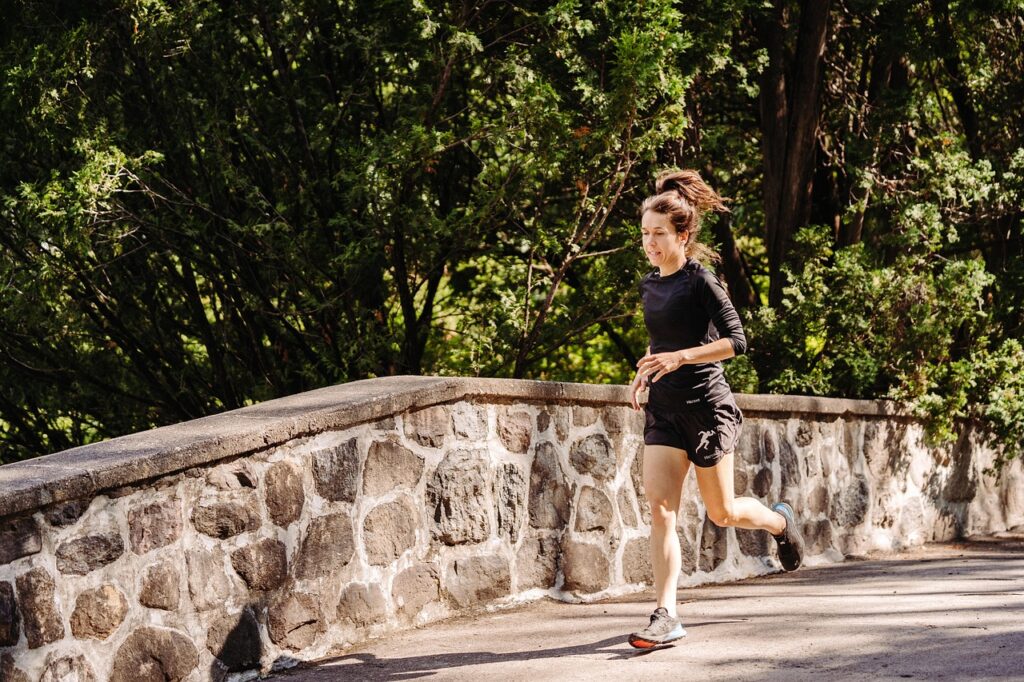
Build Aerobic Fitness
Improving your aerobic fitness is a vital component of your preseason training plan as a female soccer player. It plays a significant role in your endurance and ability to maintain a high intensity throughout the game. Here’s an expanded look at how to enhance your aerobic fitness and integrate it into your training plan:
The Importance of Aerobic Fitness
- Aerobic fitness is the foundation of your endurance on the soccer field. It refers to your body’s ability to efficiently use oxygen during prolonged physical activity. By improving your aerobic capacity, you enhance your cardiovascular system’s efficiency, allowing you to perform at a high intensity for extended periods without fatigue.
Activities for Aerobic Fitness
- To improve your aerobic fitness, incorporate activities such as running, cycling, or swimming into your training routine. These exercises engage large muscle groups and elevate your heart rate, promoting cardiovascular adaptations. Aim for a combination of different workouts to add variety and challenge your body in different ways.
Long-Distance Runs
- Include long-distance runs in your training plan to build endurance. Gradually increase the distance and duration of your runs over time to progressively challenge your aerobic capacity. Focus on maintaining a steady pace that allows you to sustain the effort for an extended period.
Interval Training:
- Integrate interval training sessions into your routine. These workouts involve alternating between periods of high-intensity effort and active recovery. For example, you can sprint for a set distance or time, followed by a period of slower jogging or walking. This method helps improve both aerobic and anaerobic fitness, simulating the intermittent nature of soccer.
Cardiovascular Workouts
- Engage in other cardiovascular activities like cycling or swimming to further enhance your aerobic fitness. These low-impact exercises provide a break from running while still challenging your cardiovascular system. Consider cross-training activities like spinning classes or swimming laps to add variety to your training routine.
YouTube Resource
- Check out this informative YouTube video to gain valuable insights and guidance on improving your aerobic fitness (link: https://www.youtube.com/shorts/aqPZBEMEEcA). While the video focuses on improving aerobic fitness also apply to soccer players. It offers tips on training techniques, workout ideas, and effective strategies to elevate your endurance levels.
Day in the life of USWNT soccer player, Alex Morgan. In this day of training Natalie Allport takes on Alex Morgan's off-season soccer skill drills, the USWNT circuit training workout, and some strength work with Natalie Allport. @NatalieAllport
Strengthen Key Muscle Groups
Incorporating strength training exercises into your preseason training plan is essential for female soccer players looking to excel on the field. You can enhance your power, stability, and overall performance by targeting the lower body, core, and upper body muscles. Here’s an expanded look at some key exercises and a YouTube video to exemplify a strength training routine:
Importance of Strength Training
- Strength training is crucial in improving athletic performance and reducing the risk of injuries. Building strength in specific muscle groups enhances your ability to generate power, maintain stability, and withstand the game’s physical demands. Additionally, strength training contributes to improved speed, agility, and overall athleticism.
Lower Body Exercises
- Exercises like squats, lunges, and deadlifts are fundamental for developing lower body strength. Squats target the quadriceps, hamstrings, and glutes, providing a solid foundation for explosive movements such as sprinting and jumping. Lunges engage multiple lower body muscles, including the quadriceps, hamstrings, glutes, and calf muscles. Deadlifts focus on the posterior chain, including the hamstrings, glutes, lower back, and core muscles, improving overall strength and power. These exercises are essential for enhancing your ability to generate force and maintain stability during dynamic movements on the field.
Core Strength Exercises
- A strong core is crucial for stability, balance, and overall functional strength. Planks are an effective exercise for engaging the core muscles, including the abdominals, obliques, and lower back. By performing planks regularly and progressing in duration and difficulty, you can improve core stability and support your movements during the game. Other exercises like Russian twists, bicycle crunches, and leg raises can also target specific core muscles and enhance overall core strength.
Upper Body Exercises
- Although soccer primarily involves lower body movements, upper body strength is still important for balance, stability, and overall athleticism. Push-ups are a classic exercise that targets the chest, shoulders, and triceps, providing upper body strength and endurance. Incorporating variations like close-grip push-ups or push-ups with a medicine ball can add challenge and variety. Additionally, exercises like dumbbell rows or pull-ups engage the back, biceps, and upper back muscles, improving overall upper body strength and posture.
YouTube Resource
- To understand a strength training routine for female soccer players, check out this informative YouTube video by Trainer Gorres (link: https://www.youtube.com/watch?v=1EGYoF7yFsM). The video demonstrates various exercises targeting the lower body, core, and upper body muscles.

Cross-Train
Incorporate cross-training activities to prevent overuse injuries, enhance overall fitness, and provide variety. Plyometrics, yoga, and swimming are excellent options. Plyometric exercises, such as box jumps and lateral bounds, improve power and explosiveness.
Preventing Overuse Injuries
- Cross-training is an effective way to prevent overuse injuries that can occur from repetitive motions in soccer. By engaging in different activities that utilize varying muscle groups and movement patterns, you reduce the strain on specific areas of your body. This helps maintain balance, reduces the risk of overloading certain muscles or joints, and minimizes the chances of developing chronic injuries.
Enhancing Overall Fitness
- Cross-training activities contribute to overall fitness and can complement your soccer training. They target different aspects of physical fitness, including strength, agility, flexibility, and cardiovascular endurance. By incorporating a variety of activities into your routine, you’ll improve your overall fitness levels, which can translate to enhanced performance on the soccer field.
Plyometric Exercises
- Plyometric exercises are particularly beneficial for soccer players as they focus on explosive power and agility. These exercises involve rapid and explosive muscle contractions, such as box jumps, lateral bounds, and explosive jumps. Plyometrics improve your ability to generate power and explosiveness, crucial for movements like jumping, sprinting, and changing direction rapidly on the field. Check out this YouTube video (link: https://www.youtube.com/watch?v=dvggf9hPwtM), showcasing a plyometric workout designed for soccer players.
Yoga for Flexibility and Mind-Body Connection
- Incorporating yoga into your cross-training routine offers numerous benefits. Yoga enhances flexibility, joint mobility, and balance, which are essential for injury prevention and improved performance. Additionally, it promotes relaxation, stress reduction, and a stronger mind-body connection. Yoga poses like the Warrior series, Downward Dog, and Tree pose target different muscle groups, stretch tight areas, and improve overall body awareness. Consider joining a local yoga class or following a guided yoga routine on platforms like YouTube to reap the benefits of this practice.
Swimming for Low-Impact Cardiovascular Training
- Swimming is an excellent cross-training activity that provides a low-impact cardiovascular workout. It engages the entire body, strengthens muscles, and improves endurance without putting stress on your joints. Swimming offers a break from the high-impact nature of soccer while still challenging your cardiovascular system. Consider incorporating swimming sessions into your training plan, whether it’s doing laps, water aerobics, or specific swimming drills tailored to your needs.
Work on Speed and Agility
Improving your speed and agility is crucial for female soccer players looking to outmaneuver opponents and make game-changing plays. By incorporating speed and agility drills into your training routine, you can enhance your quickness, acceleration, and change of direction.
Cone Drills
- Cone drills are excellent for improving agility, footwork, and change of direction. Set up cones in various patterns, such as the T-drill or the 5-10-5 drill (also known as the “Pro Agility” drill). These drills require quick reactions, precise movements, and efficient change of direction. This YouTube video (link:https://www.youtube.com/watch?v=uJTYDAuyBWI) demonstrates different cone drills designed to improve soccer players’ speed and agility.
Ladder Drills
- Ladder drills are fantastic for improving foot speed, coordination, and agility. Set up an agility ladder on the ground and perform various movements through the ladder, such as high knees, lateral shuffles, and quick steps. These drills help you develop rapid footwork and improve your ability to change direction with speed. This YouTube video (link: https://www.youtube.com/watch?v=IeMYh7roBjk) provides a comprehensive speed and agility training session that includes ladder drills. The video offers a variety of ladder drills and demonstrates how to perform them correctly.
Shuttle Runs
- Shuttle runs are an effective way to improve your acceleration, deceleration, and change of direction abilities. Set up a designated distance and mark two points at each end. Sprint from one point to the other and touch the ground before changing direction and sprinting back. Repeat this shuttle run pattern several times, focusing on explosiveness and quick changes of direction. Incorporating shuttle runs into your training routine will help improve your agility and speed on the field.
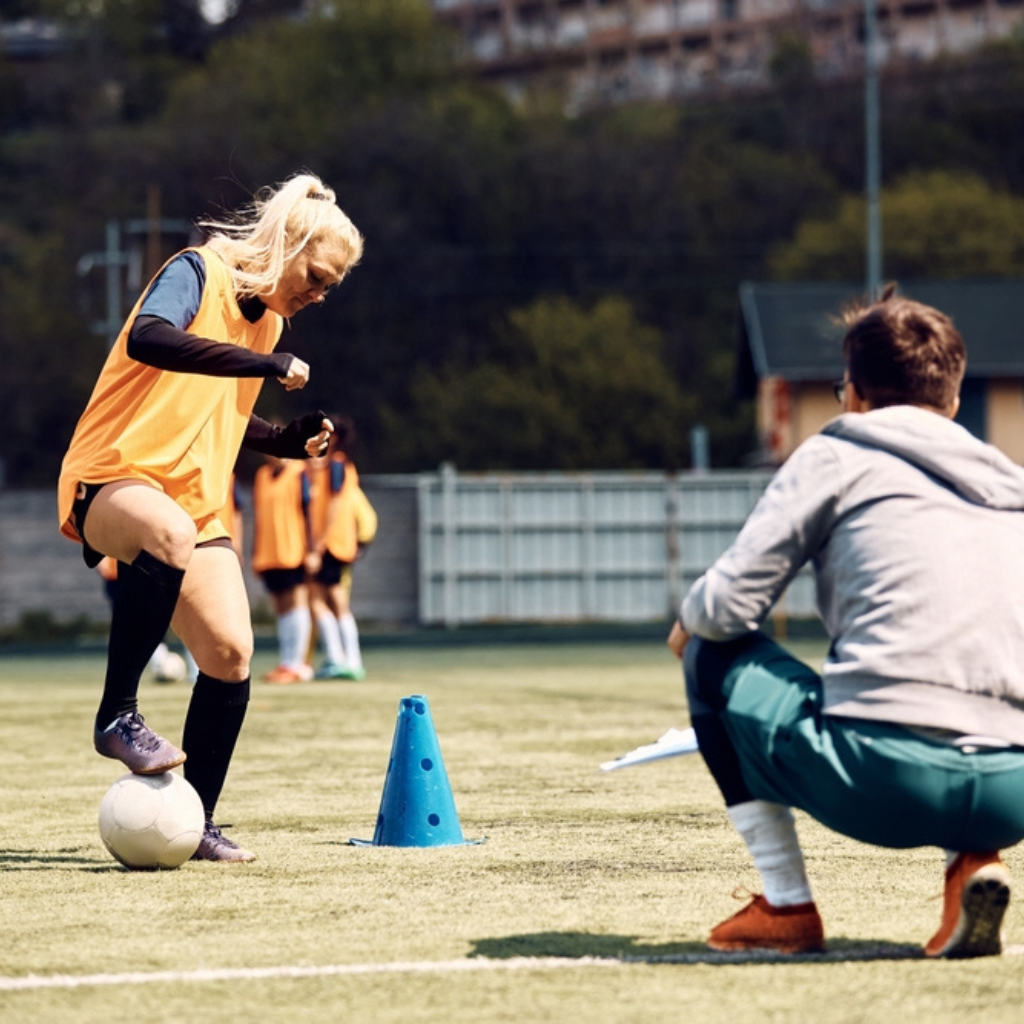
Enhance Soccer-specific Skills
Dedicating time to practicing and honing your soccer-specific skills is crucial for female soccer players who aim to excel in their sport. By focusing on fundamental skills such as dribbling, passing, shooting, and ball control, you can elevate your performance on the field.
Dribbling
- Dribbling is a fundamental skill that allows you to maintain control of the ball while maneuvering past opponents. Work on your close ball control, quick footwork, and changes in direction. There are various drills and exercises you can incorporate into your training. Check out this YouTube (link: https://www.youtube.com/shorts/yhvY_AELwrg) for a comprehensive guide on improving your dribbling skills. The video offers valuable tips and demonstrations on different dribbling techniques, drills, and practice routines.
Shooting
- Mastering your shooting technique can significantly impact your ability to score goals. Work on your shooting accuracy, power, and ability to shoot from different positions and angles. This YouTube video by Soccer Coach TV (link: https://www.youtube.com/watch?v=8iMMTlCzOlM) demonstrates a range of shooting drills and exercises that can help you improve your shooting skills. The video covers shooting techniques with both feet and drills to enhance your shooting accuracy and power.
Ball Control
- Ball control is the foundation of your soccer skills. It involves your ability to effectively receive, trap, and manipulate the ball. Focus on improving your first touch, controlling the ball in tight spaces, and maintaining possession. This YouTube video by Become Elite (link: https://www.youtube.com/watch?v=g8o8lWSEBh0) provides a comprehensive ball control exercise and drill tutorial. The video covers different aspects of ball control, including receiving the ball, turning with the ball, and maintaining close control in various situations.

Include Plyometric Exercises
Plyometric exercises are essential for female soccer players aiming to enhance their power, explosiveness, and agility on the field. These dynamic movements simulate the demands of soccer, improving your ability to jump, sprint, and change direction rapidly. Incorporating plyometric exercises such as box jumps, lateral bounds, and explosive jumps into your training routine can have a significant impact on your performance.
Box Jumps
- Box jumps are an excellent plyometric exercise for developing explosive power in your lower body. Find a sturdy box or platform at a height that challenges you but still allows for safe landing. Stand in front of the box with your feet shoulder-width apart, then explosively jump onto the box, landing with both feet simultaneously. Step down carefully and repeat the movement. This YouTube (link: https://www.youtube.com/watch?v=z4dD7ilBTMM) showcases a plyometric workout routine that includes box jumps. The video provides demonstrations and instructions on proper form and progression for box jumps.
Lateral Bounds
- Lateral bounds improve your lateral power, agility, and stability. Begin by standing with your feet shoulder-width apart and slightly bending your knees. Explosively jump sideways, pushing off with one leg and landing on the other, then immediately jump back in the opposite direction. Focus on generating power from your legs and maintaining control throughout the movement. Repeat this lateral bounding motion for a desired number of repetitions or time. Incorporating lateral bounds into your training routine will enhance your lateral explosiveness and improve your ability to change direction rapidly on the field.
Explosive Jumps
- Explosive jumps are another effective plyometric exercise for developing power and explosiveness in your lower body. Start by standing with your feet hip-width apart and knees slightly bent. Jump vertically as high as possible, driving through your legs and engaging your core. Land softly with bent knees to absorb the impact, then immediately jump again. Repeat the explosive jumps for a desired number of repetitions or time. This exercise helps improve your vertical leap, overall power, and explosiveness, which are essential for winning headers and contesting for the ball.
Maintain Proper Nutrition
Proper nutrition and hydration are vital components of a successful training regimen for female soccer players. Fueling your body with a well-balanced diet consisting of lean proteins, whole grains, fruits, and vegetables provides the necessary nutrients for optimal performance and recovery. Additionally, staying hydrated by drinking sufficient water throughout the day is essential to maintain peak performance on the field.
Nutrition
- To optimize your performance, focus on a well-rounded diet supporting your energy needs and promoting muscle recovery. Incorporate lean proteins like chicken, fish, or tofu to support muscle repair and growth. Whole grains such as quinoa, brown rice, and whole wheat bread provide sustained energy. Fruits and vegetables are rich in vitamins, minerals, and antioxidants that promote overall health and recovery.
Hydration
- Staying adequately hydrated is crucial for maintaining optimal performance and preventing dehydration. Water is essential for regulating body temperature, transporting nutrients, and lubricating joints. Female soccer players should aim to drink sufficient water throughout the day, especially during training sessions and games. Additionally, consider replenishing electrolytes lost through sweat by consuming sports drinks or adding electrolyte-enhancing products to your water. This YouTube video (Link: https://www.youtube.com/watch?v=Ilj3olaljAw ) offers valuable insights on proper hydration for athletes, including hydration tips and strategies.
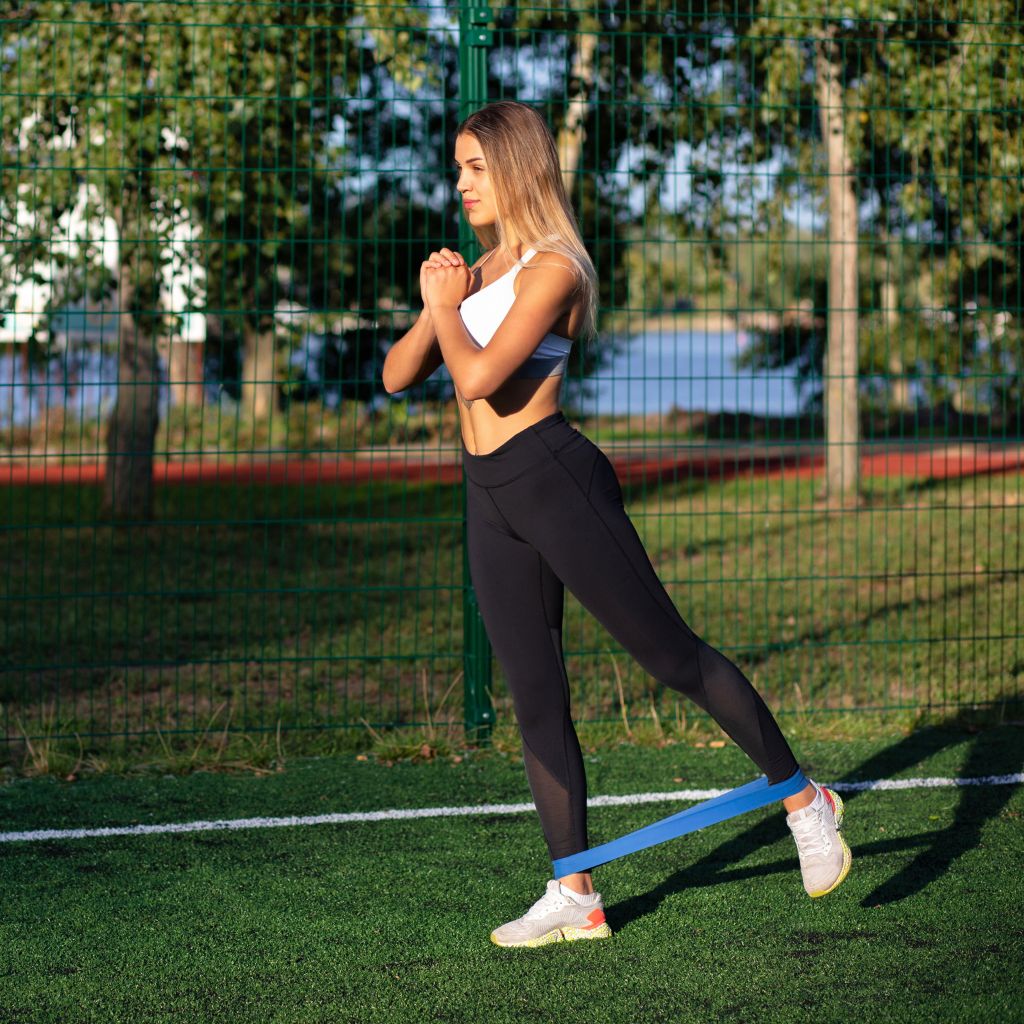
Focus on Flexibility and Injury Prevention
Incorporating dynamic warm-up exercises, static stretching, and mobility work into your training routine is crucial for enhancing flexibility and reducing the risk of injuries. Additionally, practices like yoga and Pilates can further improve flexibility, core strength, and overall body control.
Dynamic Warm-Up
- A dynamic warm-up routine prepares your body for the physical demands of training and competition. It involves active movements that increase blood flow, loosen up muscles, and enhance joint mobility. Examples of dynamic warm-up exercises for soccer players include leg swings, high knees, lunges with twists, and hip circles. This YouTube video (link: https://www.youtube.com/shorts/TIYKpqko9PY) demonstrates a dynamic warm-up routine specifically designed for soccer players. The video provides a step-by-step guide to help you perform these exercises effectively
Static Stretching and Mobility Work
- After completing your dynamic warm-up, incorporate static stretching and mobility exercises. Static stretching involves holding a stretch for a specific period to improve muscle flexibility and range of motion. Focus on stretching major muscle groups used in soccer, including the quadriceps, hamstrings, calves, hip flexors, and glutes. Mobility exercises like hip circles, shoulder rolls, and ankle circles help improve joint mobility and flexibility. Incorporating these exercises into your routine can enhance your overall flexibility and reduce the risk of muscle imbalances and injuries.
Yoga and Pilates
- Yoga and Pilates are excellent practices for improving flexibility, core strength, body control, and mental focus. These practices combine gentle stretching, strength-building exercises, and mindful breathing. Yoga, in particular, emphasizes flexibility, balance, and stress reduction. Pilates focuses on core strength, stability, and alignment. This YouTube video (link: ) offers a yoga routine specifically designed for soccer players. The video provides guided instructions for a yoga session that incorporates poses and movements beneficial for enhancing flexibility and core strength.
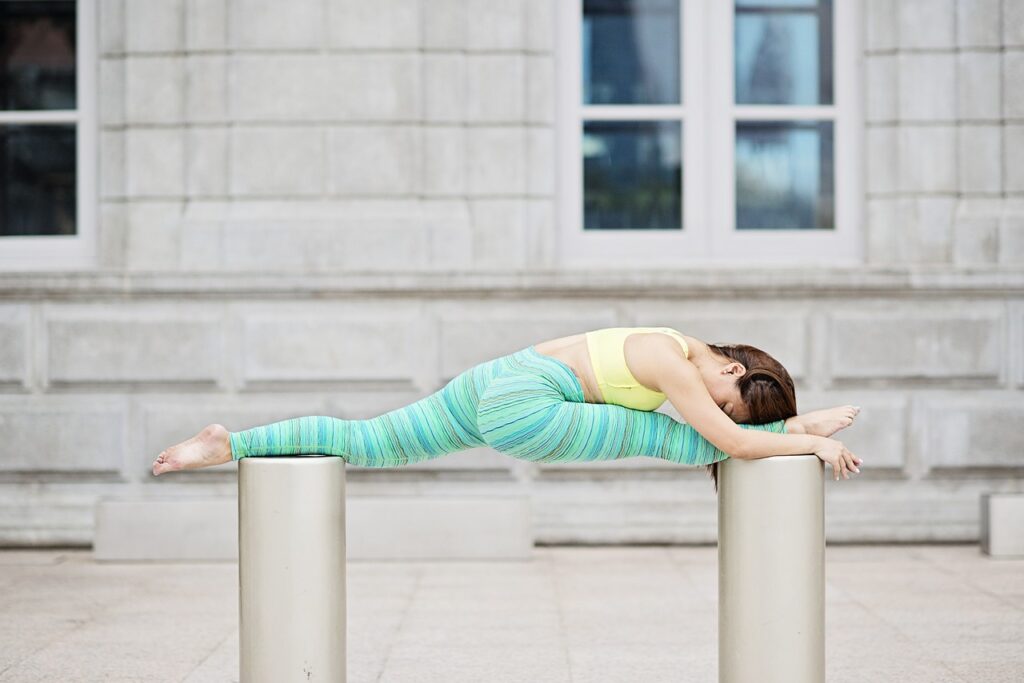
Mental Resilience
Building mental resilience is a crucial aspect of soccer performance, allowing you to maintain focus, manage pressure, and overcome challenges with confidence. By incorporating visualization techniques, setting SMART goals, practicing mindfulness exercises, and seeking support, you can develop the mental toughness necessary to excel on the field.
Visualization Techniques
- Visualization involves creating detailed mental images of successful performances. By visualizing yourself executing skills flawlessly, scoring goals, and making decisive plays, you build confidence and a mental blueprint for success. This YouTube video (link:https://www.youtube.com/watch?v=hjCrnwbkx-A) provides valuable insights and techniques for incorporating visualization into your training routine.
Setting SMART Goals
- Setting goals that are specific, measurable, achievable, relevant, and time-bound (SMART goals) is crucial for maintaining motivation and tracking progress. By setting clear objectives, you create a roadmap for success and stay focused on continuous improvement. Whether it’s improving a specific skill, increasing your endurance, or achieving team-related goals, setting SMART goals provides structure and direction to your training. This YouTube video by Simply Soccer (link: https://www.youtube.com/watch?v=OXA6gfzFA24) offers valuable insights on setting and achieving SMART goals for soccer players.
Mindfulness Exercises
- Practicing mindfulness exercises, such as deep breathing and meditation, helps you cultivate mental clarity, reduce stress, and stay present in the moment. By learning to quiet your mind and focus on the task, you enhance your decision-making abilities and optimize your performance on the field. This YouTube video (link: https://www.youtube.com/watch?v=isr3FbjFa64)
Journaling for Self-Reflection
- Journaling can be a valuable tool for self-reflection and identifying areas of improvement. By jotting down your thoughts, emotions, and experiences, you gain insights into your performance, identify patterns, and set intentions for growth. Regularly reviewing your journal entries helps you track your progress, celebrate achievements, and identify areas that require further development.
Seeking Support
- Don’t hesitate to seek support from coaches, teammates, or a sports psychologist. They can provide guidance, mentorship, and specialized mental strategies tailored to your individual needs. Engaging in discussions with others who understand the challenges of soccer can offer new perspectives and valuable advice.
Building mental resilience is an ongoing process that requires dedication and practice. By incorporating visualization techniques, setting SMART goals, practicing mindfulness exercises, journaling, and seeking support, you can strengthen your mental resilience and perform at your best on the soccer field. Embrace the power of the mind and unleash your full potential.

Rest and Recovery
Rest and recovery are crucial components of your training regimen, allowing your body to repair, recharge, and grow stronger. You can optimize your performance and prevent overtraining by incorporating proper rest and recovery practices into your routine, such as getting enough sleep, taking rest days, and engaging in active recovery activities.
Getting Enough Sleep
- Adequate sleep is essential for physical and mental rejuvenation. It allows your body to repair damaged tissues, restore energy levels, and consolidate learning and memory. Aim for 7-9 hours of quality sleep each night to support optimal performance. This YouTube video (link: https://www.youtube.com/watch?v=eeX4isWJ5ys) explains the importance of sleep for athletes and offers tips for improving sleep quality.
Taking Rest Days
- Scheduled rest days are vital for recovery and injury prevention. They give your body time to heal, reduce fatigue, and replenish energy stores. Use rest days to engage in activities that promote relaxation, such as gentle stretching, foam rolling, or light mobility exercises. This YouTube video (link: https://www.youtube.com/shorts/vAgrdFY8k-Q) provides a guided stretching routine for rest days, helping to improve flexibility and relieve muscle tension.
Active Recovery
- Incorporating active recovery activities into your routine helps enhance blood circulation, flush out metabolic waste, and promote muscle repair. Examples include light jogging, cycling, swimming, or engaging in low-impact exercises like yoga or Pilates.
By prioritizing rest and recovery, you allow your body to adapt to the physical demands of training, reduce the risk of overuse injuries, and optimize your performance on the soccer field. Remember, rest is not a sign of weakness but an essential part of your journey to becoming a stronger and more resilient athlete.
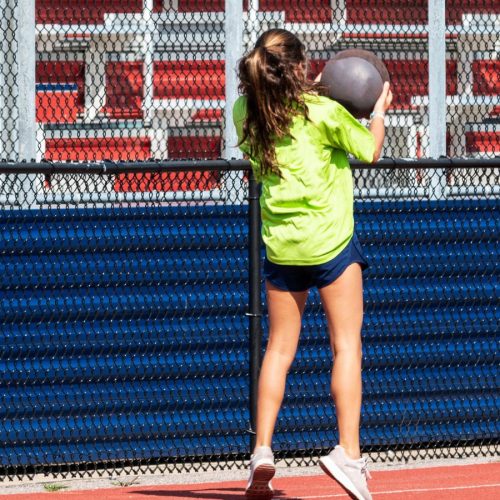
Summary: Preseason Training Guide for women Soccer Players
Preseason training is critical for women soccer players to prepare for a successful season.
By establishing a comprehensive training plan, building aerobic fitness, strengthening key muscle groups, cross-training, working on speed and agility, enhancing soccer-specific skills, including plyometric exercises, maintaining proper nutrition, focusing on flexibility and injury prevention, mental resilience, and prioritizing rest and recovery, you can maximize your performance on the field.
Remember to stay consistent, listen to your body, and seek professional guidance when needed. With dedication and perseverance, you’ll be well-prepared to excel in the upcoming season and achieve your soccer goals.


